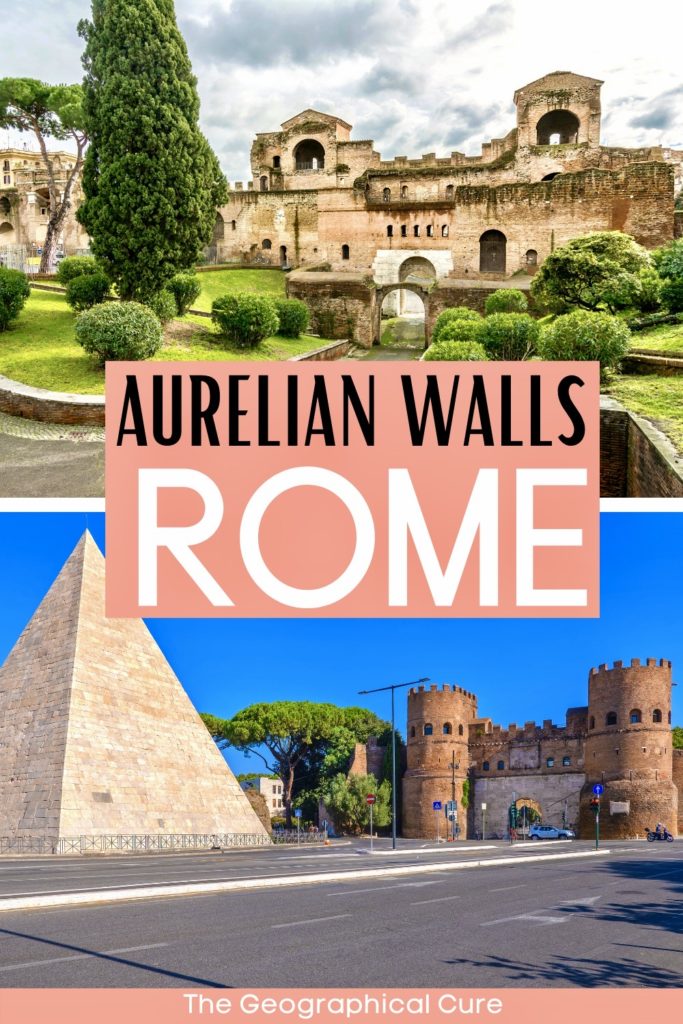Here’s my guide to the Aurelian Walls in Rome. They’re one of the biggest, but most neglected, ruins from Ancient Rome.
The Aurelian Walls date from the 3rd century. They were 12 miles long and 26 feet high, with 14 gates and 380 watch towers.
The Aurelian Walls take their name from Emperor Aurelian, a warrior emperor who sought to protect Rome from barbarians.
The walls are well worth a visit, especially for repeat visitors to Rome.
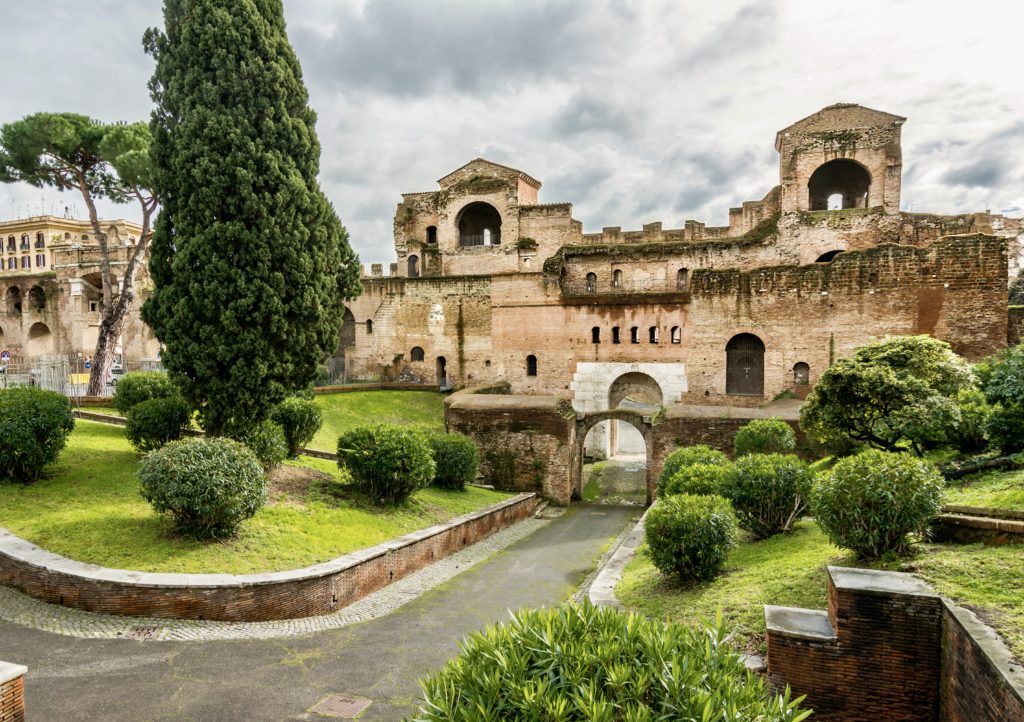
Some of the 1,700 year old walls were demolished or fell into ruin. But large sections are still visible and scattered throughout the city. You can walk on them at two points.
History of the Aurelian Walls
These days, there are many ways to get into Rome, whether by modern road or the Leonardo Express from the airport. But, in ancient times, Rome was more concerned with keeping people out.
In the mid 3rd century, the Roman Empire teetered on collapse. The city urgently needed protection from marauding barbarians. To fix the problem, a series of brilliant emperors built the Walls of Aurelian.
The 3rd century wasn’t a great time for the emperors of Rome. It been dubbed “the Crisis of the Third Century.”
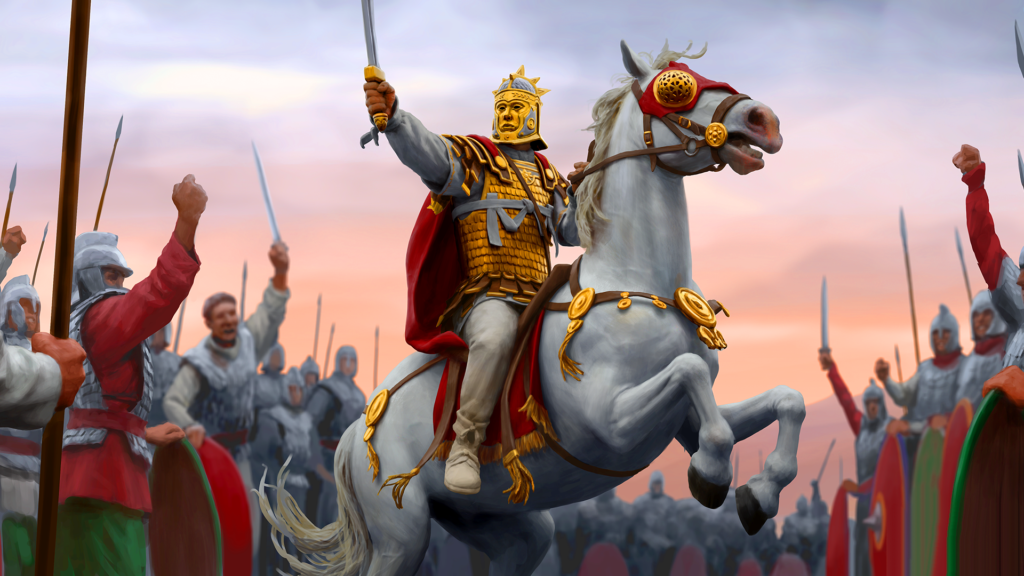
Life expectancy was short. Some emperors ruled for mere days.
They were murdered on the battlefield or by assassins, usurped by power grabs, or pushed aside. Rome was in a constant state of siege.
In the western empire, Postumous became a breakaway pretender to the throne. He murdered the emperor’s son, and set up his own Gallic kingdom.
In the east, the wily queen Zenobia exploited the chaos in the Roman Empire. She overturned Roman control and established her own empire in what is now modern Middle East and Egypt.

Was the Roman Empire drawing to a close? Not quite yet.
By 270 A.D., Aurelian had shot up through the ranks of important Romans and become emperor.
He was an effective general and a capable administrator. Aurelian defeated the encroaching barbarians in a series of battles.
But the lesson of Rome’s vulnerability wasn’t lost on him. Aurelian knew Rome needed more protection. The city hadn’t upgraded its walls since the 4th century B.C.
Aurelian drew up plans for massive walls and defensive fortifications to protect Rome. In 271 A.D., construction began in earnest.
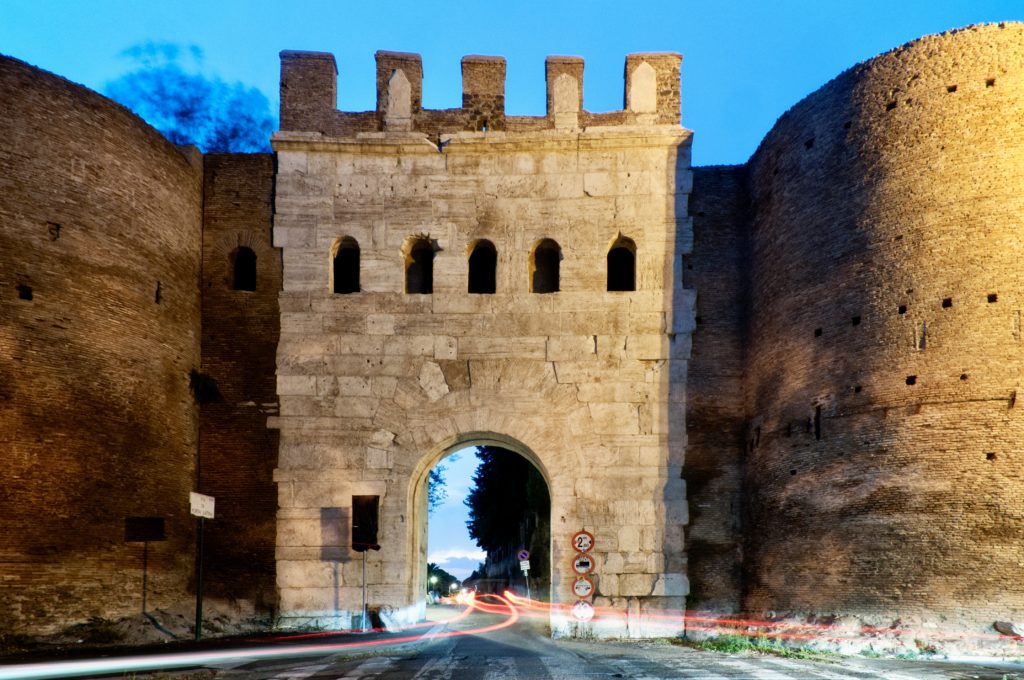
The Aurelian Walls were built between 271-275. They enclosed nearly l5.5 square miles. The walls were 10 feet thick and nearly 30 feet high.
Every 100 feet, a square defensive tower was added. The walls were built with brick faced concrete.
In Aurelian’s project, there were two main gates. They were covered with arches and two semicircular towers. More modest entrances were inserted in the stretches of walls between two gates.
The need for speed and economy meant that the Aurelian Walls incorporated existing Roman buildings, like the Pyramid of Cestius and the Claudian Aqueduct.
It was an engineering achievement that they were built so quickly. The walls protected Rome from barbarians for over a century.
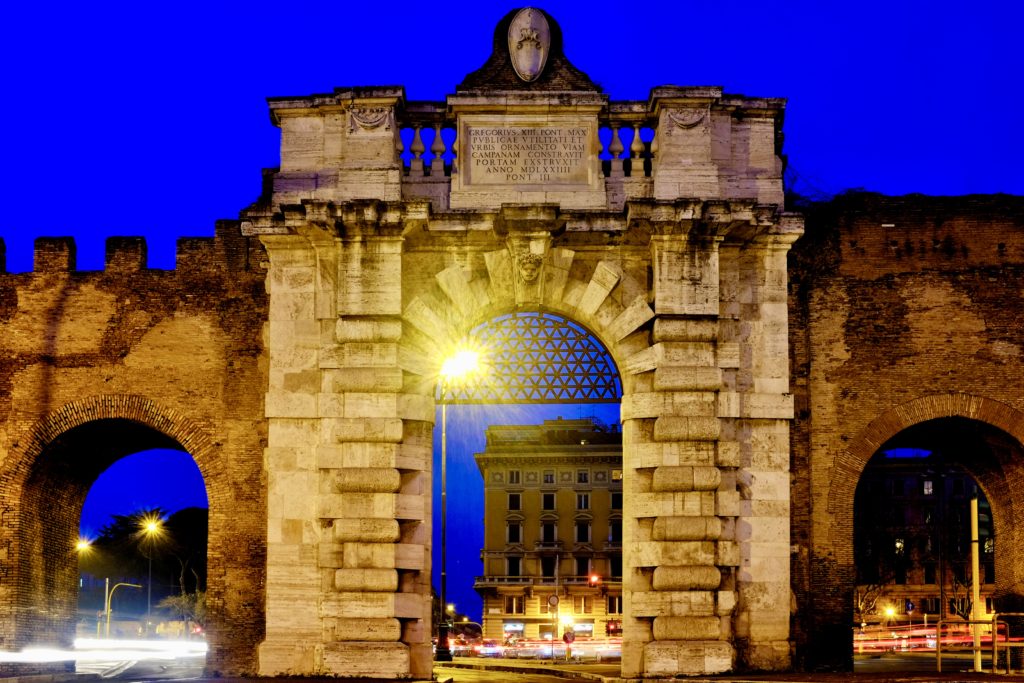
Meanwhile, Aurelian the warrior king got busy.
He vanquished Queen Zenobia and her breakaway empire in the east. Then, he defeated the ineffectual leaders of the west, reunifying the entire Roman Empire.
But not even such an exalted leader was exempt from the usual plotting in Rome. In 275 A.D., in a conspiracy manufactured by an errant servant, Aurelian was struck down by false enemies before he could even detect them.
This was a blow to Rome, which was finally getting back on its feet. One can only imagine what Aurelian might have accomplished in his lifetime. It’s one of history’s great “what ifs?”
Aurelian didn’t live to see the walls that bear his name. It fell to his successor Probus to complete the work.
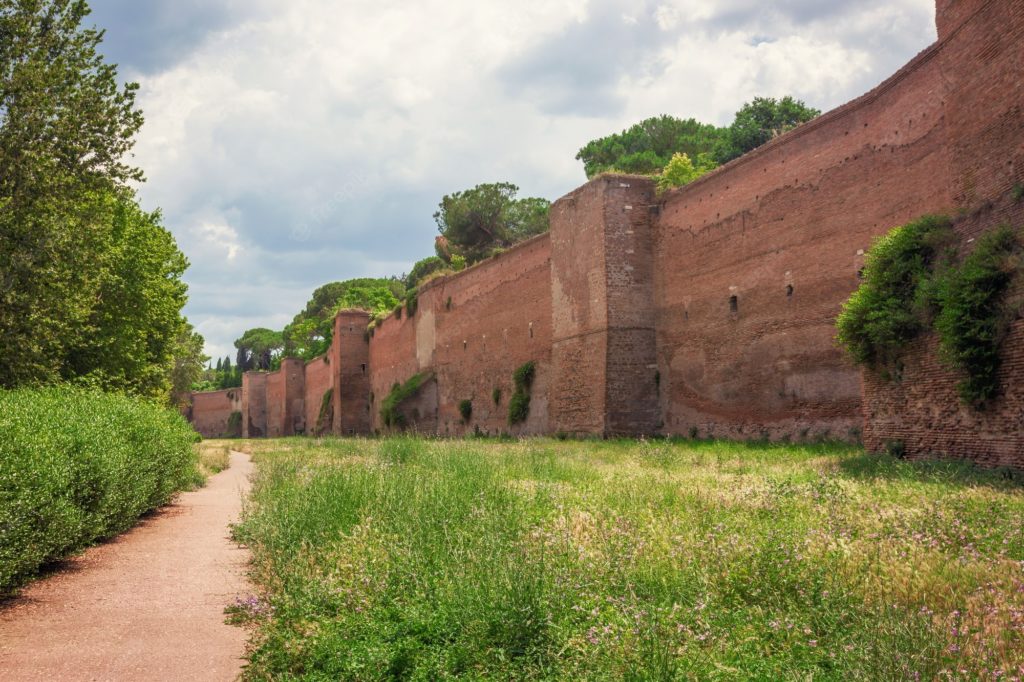
The emperors Arcadius and Honorius made further reinforcements. The two main gates were transformed into self sufficient fortresses. The height of the walls was increased to about 52 feet.
The walls survived the fall of Rome, though parts of the wall were later torn down during the Middle Ages. They continued to serve a defensive function, until they were breached in 1870. This marked the beginning of the unification of Italy.
In more modern times, parts of the walls were demolished to make way for modern infrastructure. Others have simply fallen into ruin.
Yet, large sections of the walls remain, about 2/3 of the original walls and several well preserved gates.

What To See At The Aurelian Walls
Today, you can visit the walls in many different parts of the city. But here are some spots along the walls you can’t miss.
If you are looking for some hidden gems in Rome, these sites are perfect for you.
1. Porta San Sebastiano
Porta San Sebastiano is the largest and best preserved gate on the Aurelian Walls.
It’s flanked by a large section of intact wall. There’s also some graffiti, including a carving of the Archangel Michael slaying a dragon.
The former name, kept for a long time, was Porta Appia. This name was used because the gate was crossed by the Appian Way.
One good reason to visit this gate is that it houses the Museum of the Walls. In the archaeological museum, which is free to visit, you’ll learn about the history and evolution of the Aurelian Walls from Ancient Rome to today.
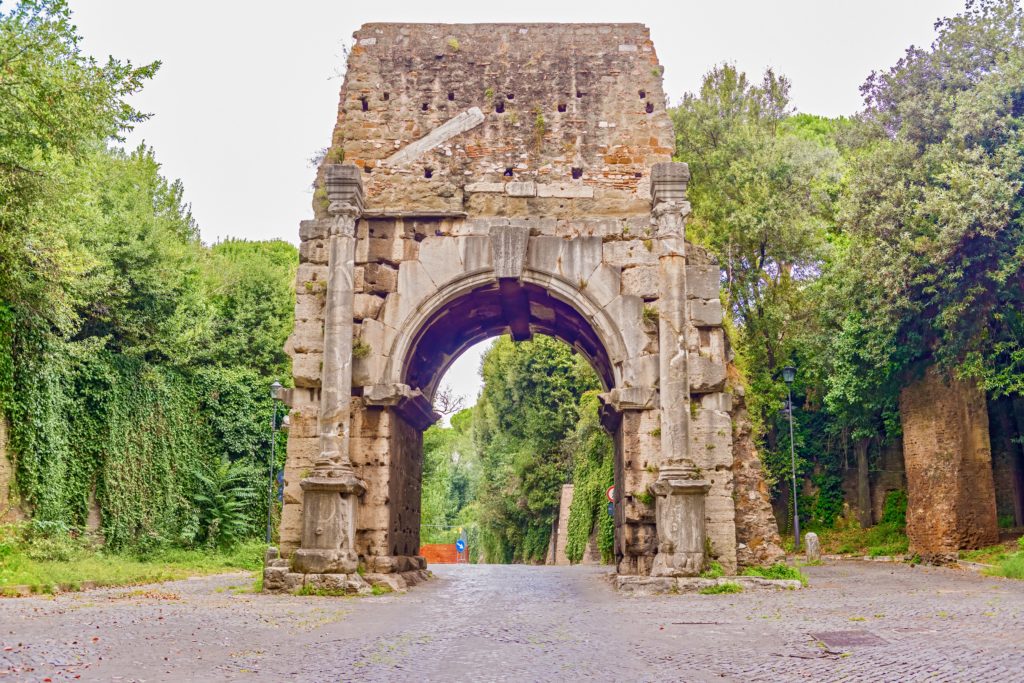
The best part of visiting the museum is that you can walk inside the gate and scramble along a well preserved section of ramparts.
You can climb to the top of the tower and gaze down at the Appian Way. You can contemplate what it would be like be a soldier at the time, always vigilant to threats and attacks.
On one side is the frenetic traffic of Rome. On the other is the ancient Appian Way.
Right behind the gate, you can see the Arch of Drusus, which was part of the ancient aqueduct system.
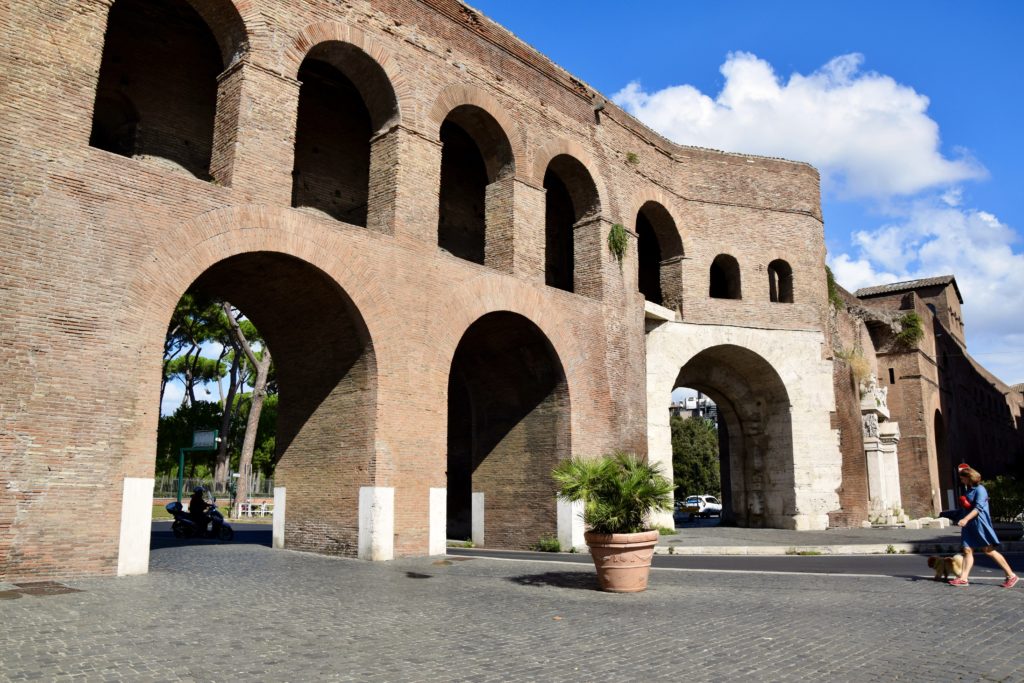
2. Porta Pinciana
Porta Pinciana is just southwest of the Villa Borghese. You can admire it on a visit to the revered Borghese Gallery.
The gates name derives from the ancient Pincia family, who owned Pinician Hill.
This gate has the original “look” from Ancient Rome, with huge arches reminiscent of Domitian’s Palace on Palatine Hill. There’s a monument in travertine attached to the gate with two eagles on top.
It was built in the 5th century by Emperor Honorius, who reworked a secondary gate on the Aurelian Walls. It also has some more modern arches to accommodate traffic.
The Porta Pinciana gives access to Via Veneto, one of Rome’s toniest streets.
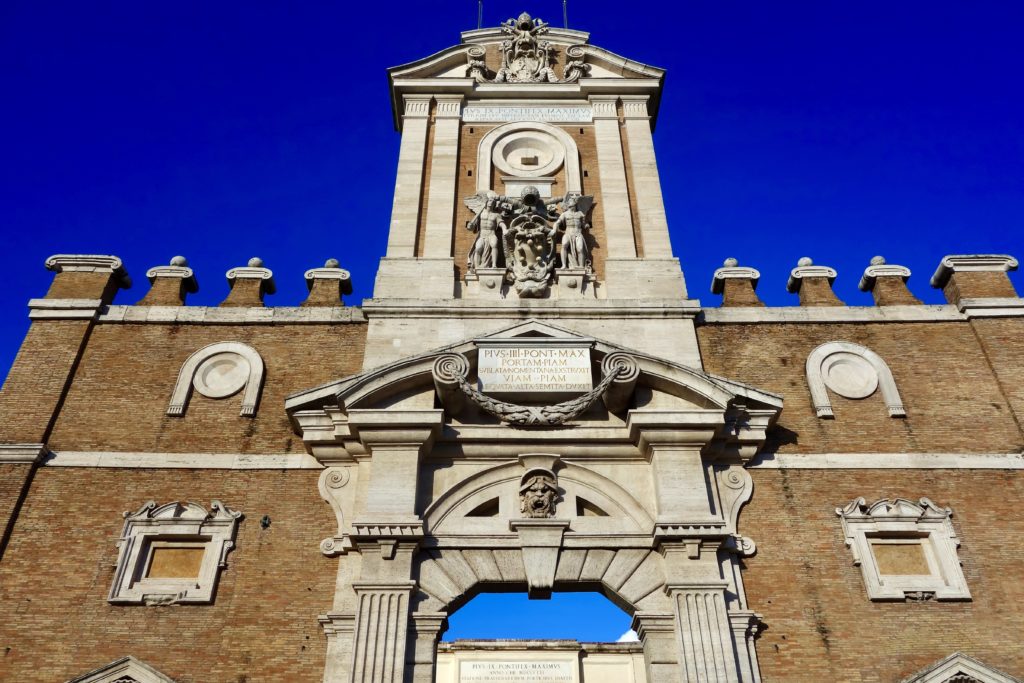
3. Porta Pia
This gate isn’t from Ancient Rome. Pope Pius IV commissioned famed Renaissance artist Michelangelo to design and build the Porta Pia on the Aurelian Way. The gate was a replacement for Porta Nomenata.
It was Michelangelo’s last architectural project. He died shortly before it was completed.
The pontiff wished to burnish his legacy with a gate sporting his name. Built in 1551-56, the crenellated gate is focused more on the city of Rome, than on those entering the gate.
In building Porta Pia, Michelangelo departed from architectural norms. The gate has an eccentric secular design with fantastical elements – broken pediments, swags, masks, displaced fragments of the orders, overlapping planes, and juxtaposed facades.
The gate was the site of an important event in Italian history. In 1870, an elite corps of the Italian army (the Bersaglieri) breached the walls and conquered Rome, a movement that led the Unification of Italy.
There’s a monument to fallen soldiers at the spot where the walls were breached. Inside the gate is the Historical Museum of the Bersaglieri.
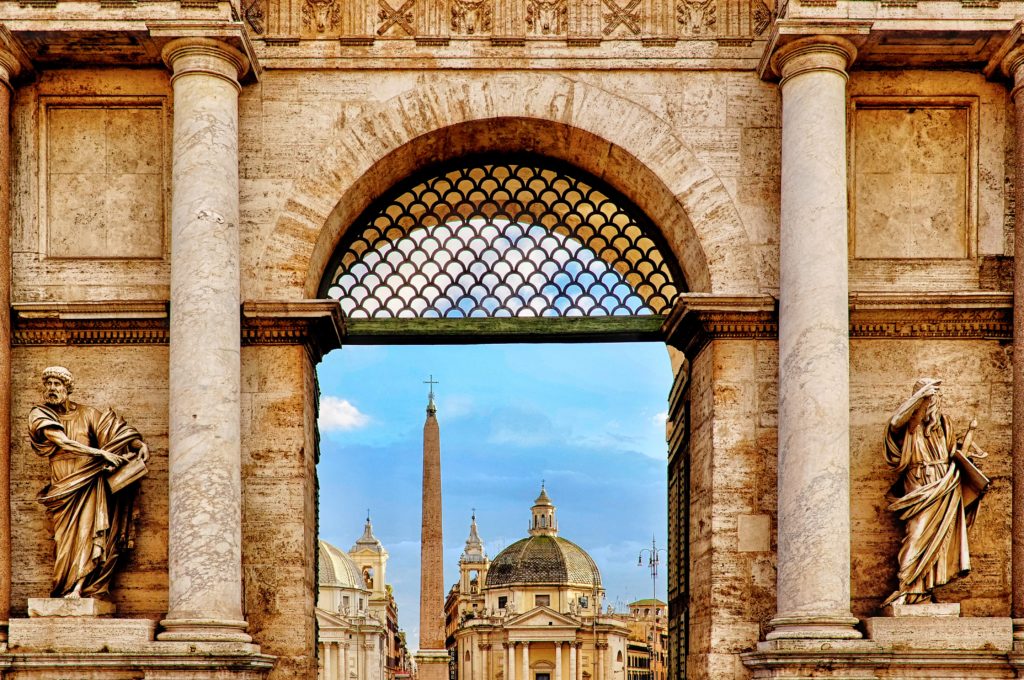
4. Porta Flaminia del Popolo
This gate is at the entrance of the Piazza del Popolo, once of Rome’s most beautiful squares. The gate is named for the Via Flaminia, the road passing through it, and the adjacent Basilica of Santa Maria del Popolo.
The exterior was remodeled in the 16th century. The interior was restored in the mid 17th century by Gian Lorenzo Bernini. Above the central arch is a message of good wishes, surmounted by the coat of arms of the Chigi family.
On each side of the main arch are statues of St. Peter and St. Paul. They were created by Francesco Mochi and added in 1638.
The basilica is definitely worth stepping inside. You can find works by the greatest Renaissance and Baroque artists of the day — Caravaggio, Raphael, Bernini, Pinturicchio, and Carracci.
The most famous works can be found in the Chigi Chapel and the Cerasi Chapel.
There’s a wonderful view from the gate overlooking the Pincio Terrace where you can see the dome of St. Peter’s Basilica.
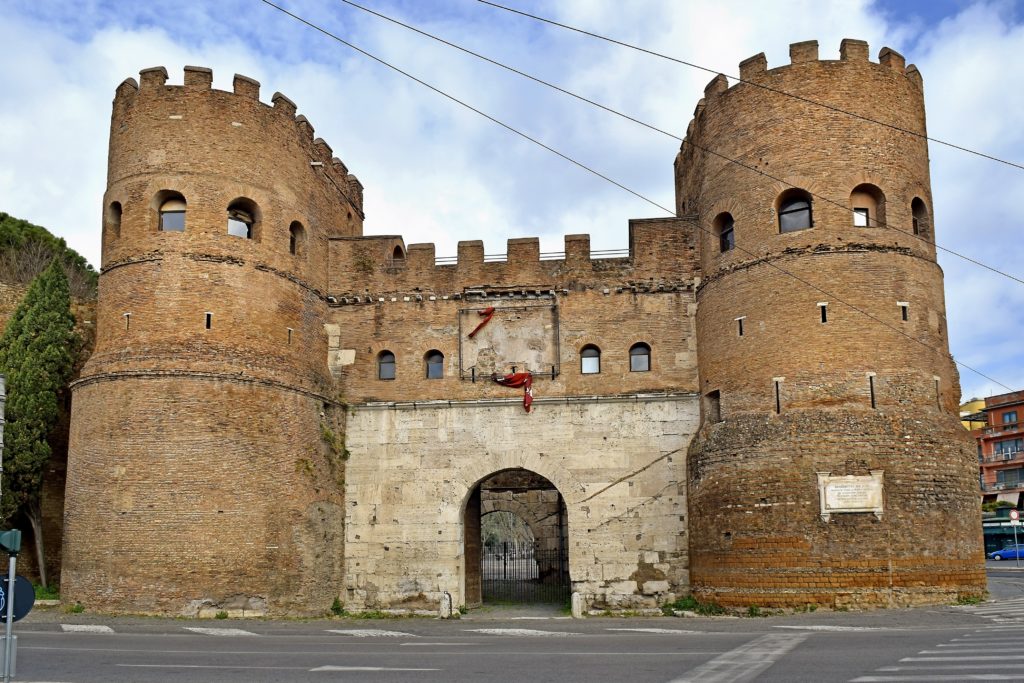
5. Porta San Paolo
The Porta San Paolo is another ancient gate on the Aurelian Walls. It was built by Aurelian and fortified by Maxentius in the 4th century.
The gate has two semi cylindrical towers and a double gateway, all topped with crenellations.
The gate houses a tiny museum, the Museo della Via Ostiense. In the museum, you can explore the gate itself and see a few models of Ostia Antica, Rome’s ancient port.
The gate is next to the Pyramid of Cestius, which was built right into the walls. The Roman pyramid was most likely built between 18 and 12 B.C. during the reign of Augustus.
READ: History of the Roman Emperors
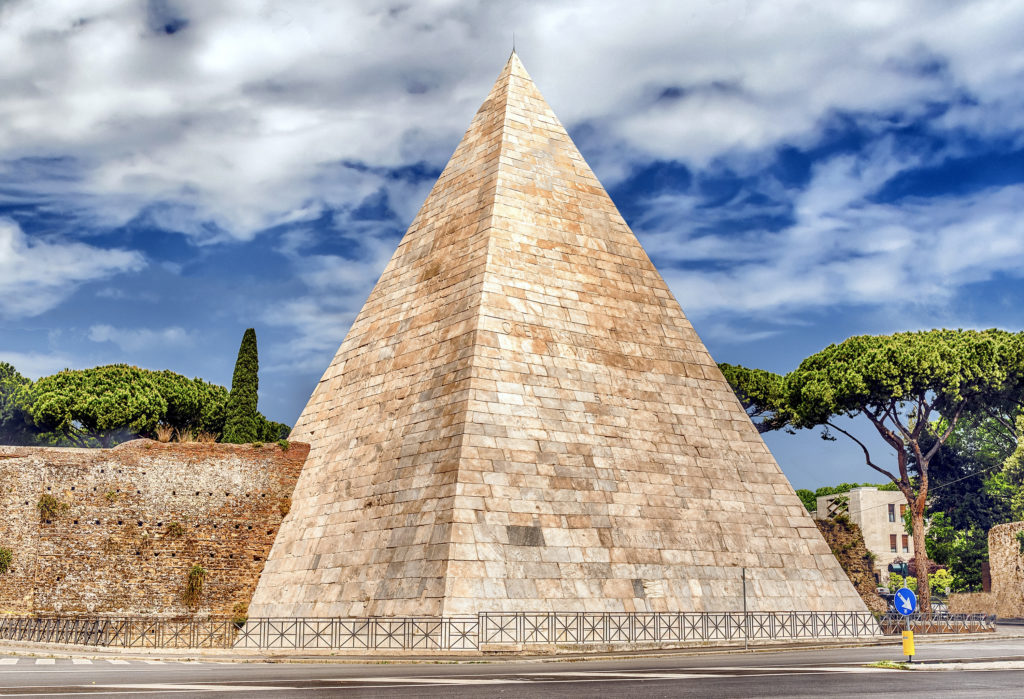
The pyramid is 120 feet high and covered in white Carrera marble.
You can tell it’s not the real deal. The pyramid is too steep and pointy, compared to the real Egyptian pyramids of Giza.
Cestius was built as a tomb for a wealthy Roman under the sway of all things Egyptian. The tomb was long ago ransacked.
The pyramid was excavated and restored in the 16th century. Many of the columns and sculptures that once surrounded it are in the Capitoline Museums.
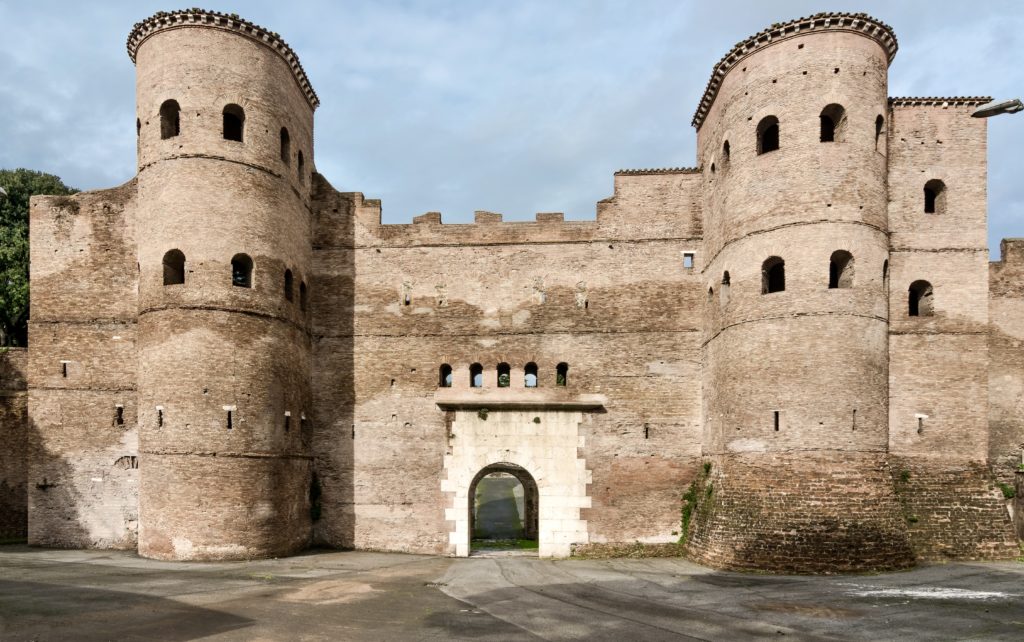
6. Porta Asinaria
The Porta Asinaria was initially a simple gate with a single archway. But it grew in importance because it was near the pope’s Basilica of St. John Lateran.
To buttress the gate’s defenses, Emperor Honorious fancied it up in the 5th Century. He added two massive semi-cylindrical towers on each side, enlarging and transforming it into a mighty defensive structure.
Over the centuries, the gate was closed and the travertine stripped from the entrance in the 16th century. In 1956, restorations were carried out. A new travertine decoration was added.
The gate is right near the San Giovani metro station. While you’re there, you should definitely visit the Basilica of St. John Lateran. It’s one of Rome’s most beautiful and important churches.
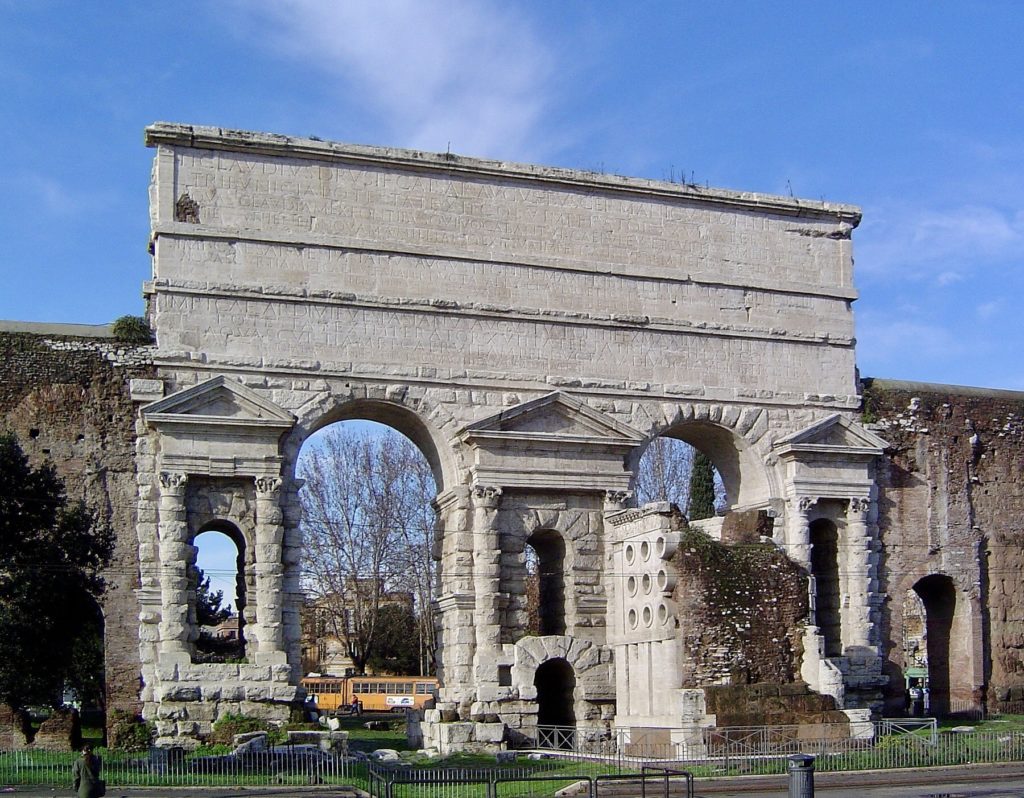
7. Porta Maggiore
Porta Maggiore is in the Piazza di Porta Maggiore on Esquiline Hill. This double arched gate was once the point where 8 of the 11 aqueducts in Rome converged. It was erected in 52 A.D. by Emperor Claudius.
It was a massive standalone monument that was incorporated into the walls and used as one of the eastern gates. In one of the arches, you can see the faint remains of a fresco.
In front of the gate is an odd looking structure. It’s the Tomb of Eurysaces, which dates from 30 B.C. Eurysaces was an important baker and purveyor for the state. His peculiar tomb mimics a device in which flour was kneaded into dough.
Unfortunately, Porta Maggiore has been somewhat neglected. It’s not in great condition. In June 2022, the gate was sealed off when one of the arches began to crumble.
In the same piazza is the underground Basilica of Porta Maggiore. It’s the oldest pagan basilica in the Western world. It was discovered by chance during construction near Termini train station.
The basilica is buried 42 feet underground and decorated with mythological frescos. It’s only open two Sundays a month. You can only visit by reservation.
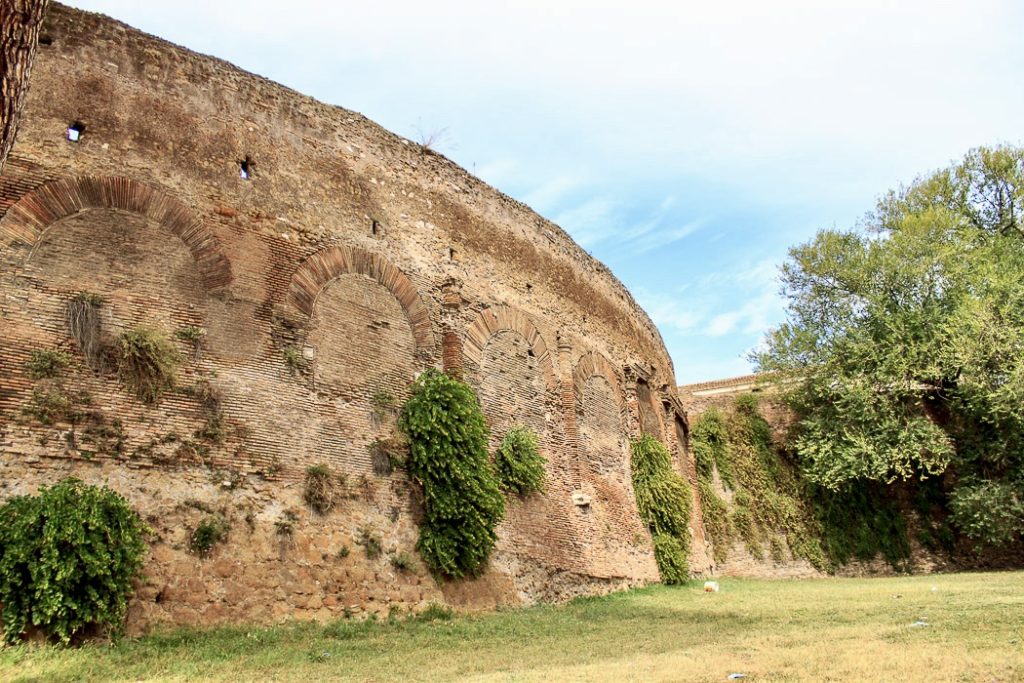
8. Amphitheater Castrense
Did you know that there’s another amphitheater in Rome besides the Colosseum?
It’s the Amphitheater Castrense and it’s incorporated in the Aurelian Walls. Scholars believe it dates from the first half of the 3rd century.
The amphitheater was constructed of brick and concrete and dates from the reign of Trajan. The ground floor arches that faced out were filled in to form part of the defense and the upper stories were demolished.
Unfortunately, the monument isn’t open to the public. You can just admire its exterior walls.
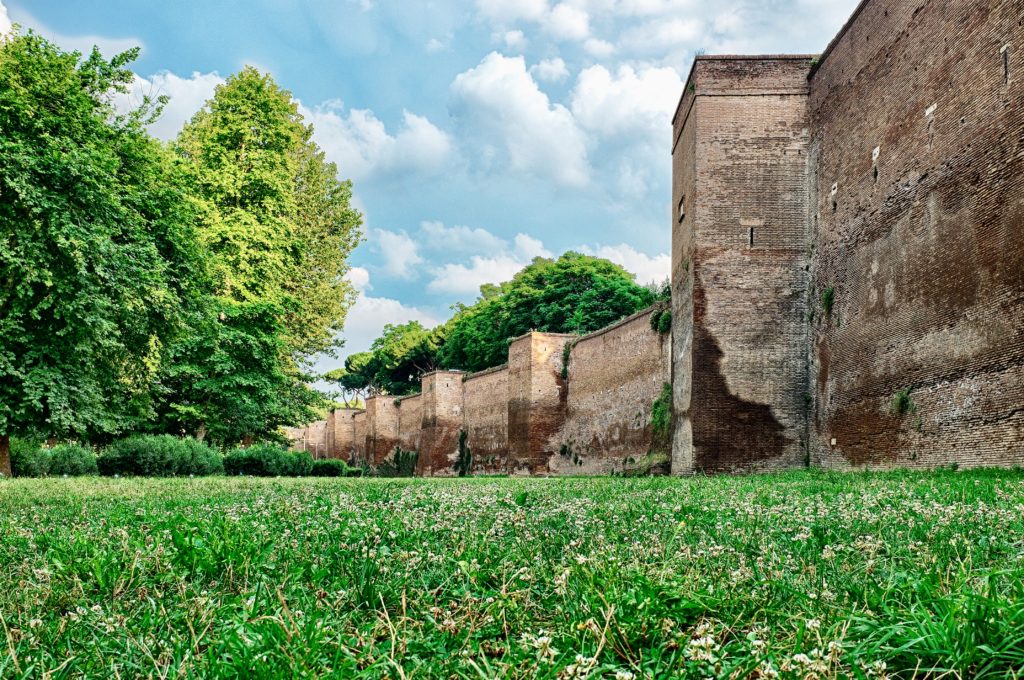
Tips For Visiting The Walls Of Aurelian
1. How To Get To The Aurelian Walls
The walls are scattered all over the city and you can’t walk around them. You may already have come across them inadvertently in your sightseeing.
You may want to start with the furthest out and best preserved gate, the Porta San Sebastiano. It’s located in the southeast part of the city. It’s about a 30 minute walk from both the Lungo Metro Station (Line A) or from the Colosseum.
From there, the best preserved stretches of the Aurelian Walls are between the Porta San Sebastiano and Porta Latina.
You can also take the metro to the Basilica of St. John Lateran. From there, you are close to the amphitheater, Porta Asinaria, and the Porta San Giovanni.
You can also explore the Aurelian Walls and other ancient ruins on a 4.5 hour guided electric bike tour, which may be the easiest and best way to see the walls since they’re spread out.
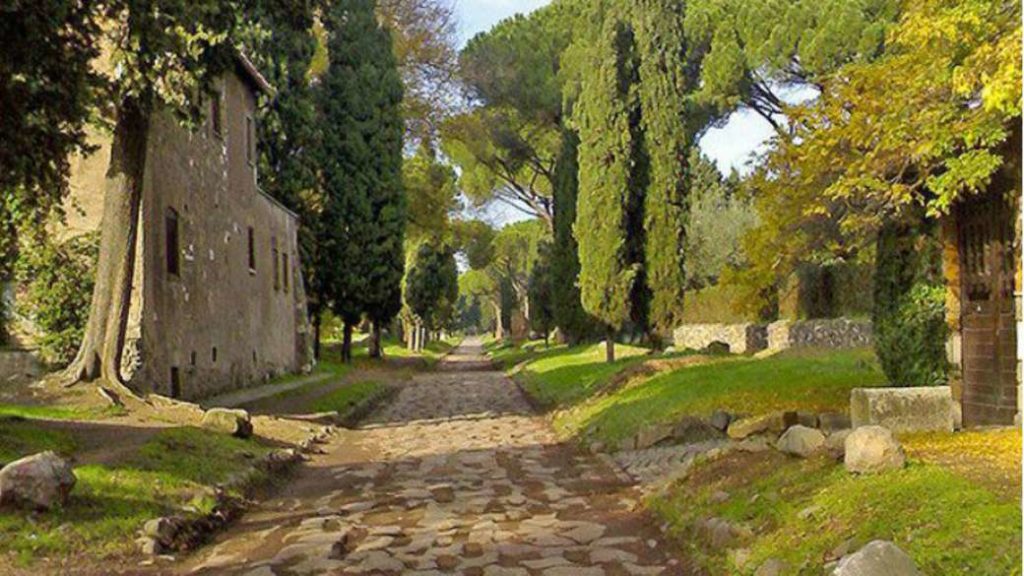
2. Park of the Scipioni
The Museum of Walls in Porta San Sebastiano is right near the Park of the Scipioni. The Scipioni were one of the noblest families in Ancient Rome. The park contains their family tomb, which is also worth seeing.
If you’re hungry while you’re visiting this area, check out the Ristorante Da Orazio a Caracalla. It has great outdoor garden seating.
3. Where To Walk The Aurelian Walls
In 2021, Rome opened up to two sections of the walls that you can walk on, apart from the museum at Porta San Sebastiano: Via Campania and Viale Pretoriano. Visits are by a 30 minute guided tour and limited to 15 people.
I hope you’ve enjoyed my guide to the Aurelian Walls. You may enjoy these other Rome travel guides and resources:
- 8 ways to spend 1 day in Rome
- 3 day itinerary for Rome
- 5 day itinerary for Rome
- Hidden gems in Rome
- Best museums in Rome
- Archaeological sites in Rome
- Guide to the Borghese Gallery
- Guide to Palatine Hill
- Guide to the Roman Forum
- Guide to the Colosseum
- Walking tour of central Rome
If you’d like to visit the Aurelian Walls, pin it for later.
